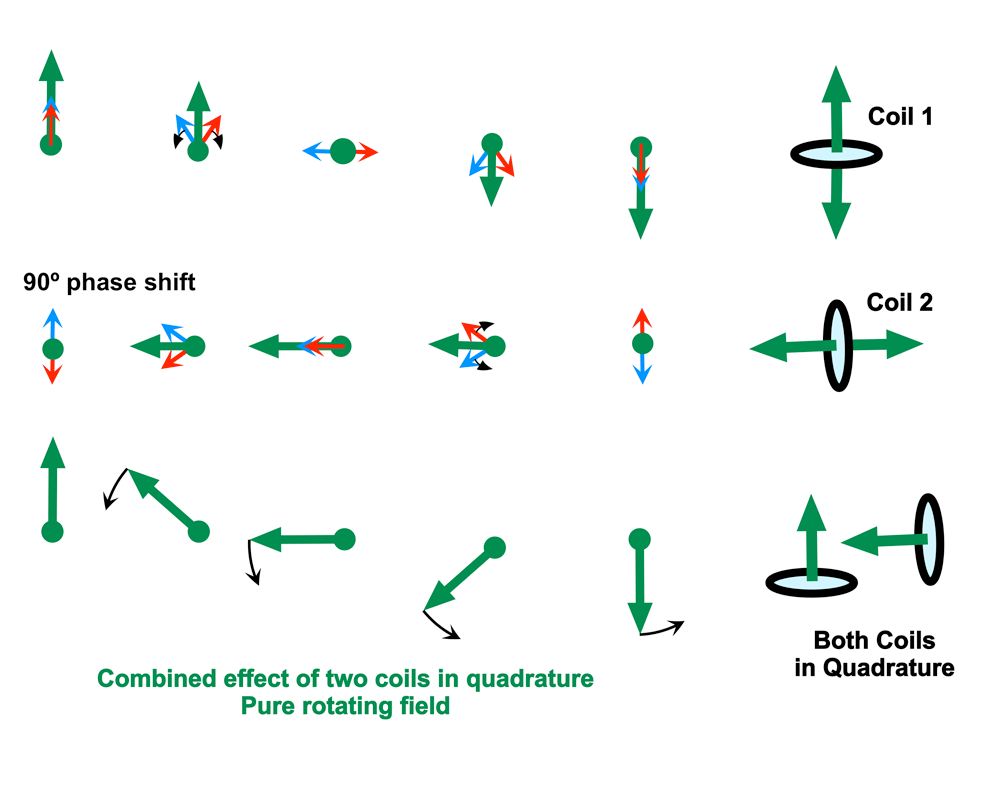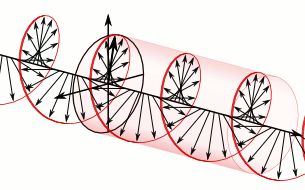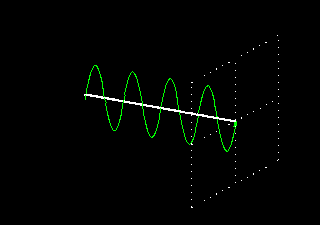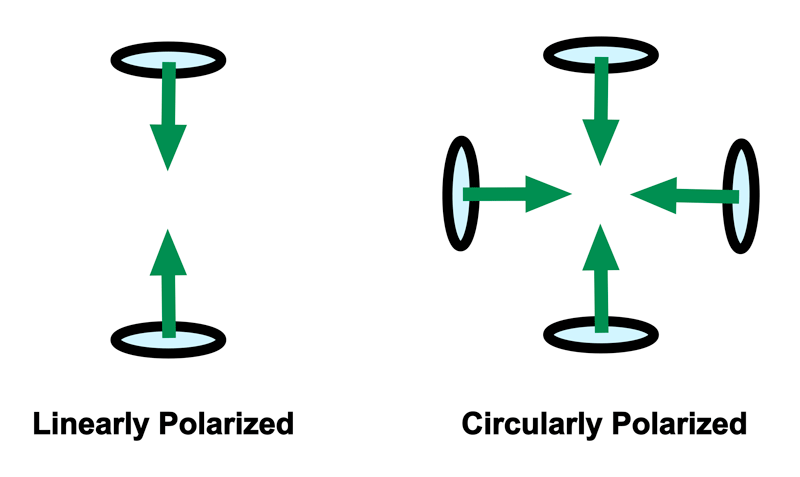The terms linear polarization (LP) and circular polarization (CP) derive from classical electromagnetic theory describing two modes of wave propagation. Readers may be more familiar with these concepts from optics, where polarizing lenses like those used in sunglasses allow light rays oscillating in a specified constrained (linear) dimension to pass through while blocking all others. The diagrams below illustrate CP and LP of wave propagation.
|
The earliest RF-coils for MR imaging were all linearly polarized (LP). In this configuration, both transmission and reception of electro-magnetic radiation took place along a single axis. In the transmit mode LP coils are inefficient in that half their power is wasted. In the receiver mode they are incapable of extracting full phase information from the the MR signal. |
The above illustration shows a Helmholz pair of coils on the left arranged in a linearly polarized (LP) configuration. The B1 RF-field (green arrows) is generated by driving the coils with a sinusoidal electric current, causing B1 to oscillate back and forth in a single direction. As explained in the previous question, any linearly oscillating field can be decomposed into 2 counter-rotating circular fields, one in the same direction and frequency as the NMR spin system and the other in the opposite direction. The oppositely rotating field constitutes "wasted" RF-power that does not affect the spin system and creates the adverse affect of heating tissues.
By adding a second set of coils perpendicular to the first and driving them with sinusoidal current phase shifted by 90°, a pure rotating B1 field can be created. This is known as circularly polarized (CP) or quadrature transmission. The unwanted counter-rotating fields from each linear coil set (denoted by red arrows below) are always 180° out of phase and hence cancel each other out. The useful subfields in sync with the spin system (blue arrows) add together vectorially to produce a rotating B1 field with no wasted power.
By adding a second set of coils perpendicular to the first and driving them with sinusoidal current phase shifted by 90°, a pure rotating B1 field can be created. This is known as circularly polarized (CP) or quadrature transmission. The unwanted counter-rotating fields from each linear coil set (denoted by red arrows below) are always 180° out of phase and hence cancel each other out. The useful subfields in sync with the spin system (blue arrows) add together vectorially to produce a rotating B1 field with no wasted power.

Vector diagram of two linearly polarized coils placed in quadrature. Each is driven by a sinusoidal current, but Coil 2 is 90° out of phase with Coil 1. The oscillating field from each coil can be decomposed into vectors rotating in the same direction as the spin system (blue arrows) and in the opposite direction (red arrows). When added together the net effect is a rotating B1 field without wasted power.
Like LP coils, CP coils can be used as transmitters, receivers, or both. The most common type of quadrature RF-transmit coil used in MRI is the birdcage coil or its variant, the transverse electromagnetic (TEM) coil. More detail about these are provided through the Advanced Discussion links below.
References
GE Healthcare. MR Field Notes: RF Coils...They've come a long, long way. 2005.
Glover GH, Hayes CE, Pelc NJ, et al. Comparison of linear and circular polarization for magnetic resonance imaging. J Magn Reson 1985; 64:255-270.
GE Healthcare. MR Field Notes: RF Coils...They've come a long, long way. 2005.
Glover GH, Hayes CE, Pelc NJ, et al. Comparison of linear and circular polarization for magnetic resonance imaging. J Magn Reson 1985; 64:255-270.
Related Questions
What is the purpose of radiofrequency (RF) coils?
I don't understand all the different types of coils in MR. Can you make sense of these?
What is a birdcage coil and how does it work?
What are TEM coils?
What is the purpose of radiofrequency (RF) coils?
I don't understand all the different types of coils in MR. Can you make sense of these?
What is a birdcage coil and how does it work?
What are TEM coils?
|
© 2024 AD Elster, ELSTER LLC
All rights reserved. |
|



